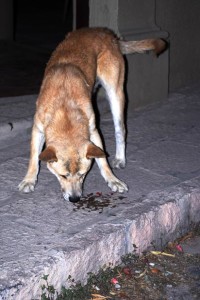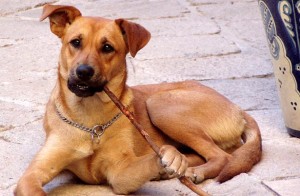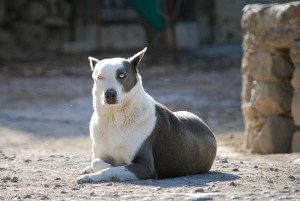 I live near a five street intersection on a hillside in San Miguel de Allende. Straight ahead, from my second floor open-air office, I can see all the way to the mountains near Guanajuato. In the afternoon, sunlight glints off the water at the reservoir. High above me the Caracol snakes past on its way between the Luciérnaga shopping mall and the Mega supermarket at the Salida a Celaya.
I live near a five street intersection on a hillside in San Miguel de Allende. Straight ahead, from my second floor open-air office, I can see all the way to the mountains near Guanajuato. In the afternoon, sunlight glints off the water at the reservoir. High above me the Caracol snakes past on its way between the Luciérnaga shopping mall and the Mega supermarket at the Salida a Celaya.
This is a neighborhood of Méxicans, Americans and Canadians living together. Two doors from my house a wedge of barrio starts from a point at its base and widens fanlike as it climbs the steep slope. Across from me and to the west and north and east are scattered the villas of expatriates, and further uphill, a five-story condo development––controversial at the time it started––that has mostly sold to week-enders from México City.
Like most of San Miguel, the streets in my intersection are smooth cobblestones anchored in a bed of dried mud. Occasionally one will pop out like a pearl from a loose bezel in a ring. The kids will kick it around until it disappears. The colors of the stucco façades on all sides are earthy and mellow; they do not give much away about what goes on behind those walls.
Outside, the streets are dominated by a single, ruthless gang, intolerant of any intruders. Although its presence is not always obvious, it is constant and pervasive. If you look closely, you can pick its members out, even in their camouflage. I know all of them by name.
 Start with Oso; some call him Bear for his fierce look. He is most often found lying on his side about a third of the way out into Prolongación Aldama. Often he is sleeping, especially in the afternoon sun. He is more relaxed now that the buses no long run up this street; the pickups will usually move out around him. Only the little old American ladies honk at him. He doesn’t pay much attention to them other than occasionally looking up to yawn. You see, Bear works the neighborhood watch during the night shift, and he needs his sleep.
Start with Oso; some call him Bear for his fierce look. He is most often found lying on his side about a third of the way out into Prolongación Aldama. Often he is sleeping, especially in the afternoon sun. He is more relaxed now that the buses no long run up this street; the pickups will usually move out around him. Only the little old American ladies honk at him. He doesn’t pay much attention to them other than occasionally looking up to yawn. You see, Bear works the neighborhood watch during the night shift, and he needs his sleep.
Then there’s Chispa, (Sparkie). Something did not quite work in Chispa’s genetic makeup. Perhaps his mother got too friendly with a dachshund one night and paid the price. He is about five or six times longer than he is high, and truthfully, he has some issues with his weight. It is unkindly said of him that he pees like a girl, squatting, but he can no longer get his leg up into the required position and he has stopped trying. On the front of my house running from one end to the other is a band about six or eight inches wide, like the mark made by the repeated passing of a wide soft brush, where Chispa scratches himself. I think he might have some flea issues too.
Don’t leave out Frizzy. He’s a mottled white and tan dog of medium height, possibly a little cross-eyed, and he has gone for and successfully holds the neighborhood peeing championship. If I step outside in the morning and find my door frame or my stoop wet, I know he’s passed. He is envied by the other gang members, because his special expertise also means he knows the location of more water sources than any other gang member.
 Poly is a smaller tan dog that is a close friend of my dog, Brownie, who’s a classic cinnamon Méxican street dog. You see her cousins on every corner, and they don’t come any smarter. Poly is lighter in color, and walks with Brownie in the morning. They are good friends; they pound each other in a friendly way, and each suspects the other of being in possession of an important mystery. Brownie lives in a house, and only steps outside on a leash. Poly suspects her of being rich, one of the 1%, and possibly well educated, although I would sometimes question this myself. He knows for certain she’s guilty of eating special food of a kind not often available on the street. His job as they walk is to provide security against others, even in his own gang, who may not appreciate her as he does. Since she’s been spayed, he’s not entirely sure what her appeal is.
Poly is a smaller tan dog that is a close friend of my dog, Brownie, who’s a classic cinnamon Méxican street dog. You see her cousins on every corner, and they don’t come any smarter. Poly is lighter in color, and walks with Brownie in the morning. They are good friends; they pound each other in a friendly way, and each suspects the other of being in possession of an important mystery. Brownie lives in a house, and only steps outside on a leash. Poly suspects her of being rich, one of the 1%, and possibly well educated, although I would sometimes question this myself. He knows for certain she’s guilty of eating special food of a kind not often available on the street. His job as they walk is to provide security against others, even in his own gang, who may not appreciate her as he does. Since she’s been spayed, he’s not entirely sure what her appeal is.
For Brownie, Poly symbolizes a dim lost recollection of the wild life she led in her youth. His scars bear witness to his hard-earned position in the gang. He knows his way around in ways that she doesn’t, but would still like to. She likes him because he’s dangerous, but she knows how to rein him in.
 At the pinnacle, at the absolute unchallenged top of the pack, is Lobo, the Wolf. From his perch in the upper levels of the barrio, he comes down only for big trouble. A larger breed of white and dark gray, his hair is short, his ears pert, his eyes a startling blue. The others tiptoe around in his presence. In his ancestry he has boxer and pit bull. He likes order and calm; occasionally he leads the others in running off cars with a noisy muffler or a pickup with too much rattle for its own good. Lobo works hard in his own way, and he enjoys partying in the wee hours.
At the pinnacle, at the absolute unchallenged top of the pack, is Lobo, the Wolf. From his perch in the upper levels of the barrio, he comes down only for big trouble. A larger breed of white and dark gray, his hair is short, his ears pert, his eyes a startling blue. The others tiptoe around in his presence. In his ancestry he has boxer and pit bull. He likes order and calm; occasionally he leads the others in running off cars with a noisy muffler or a pickup with too much rattle for its own good. Lobo works hard in his own way, and he enjoys partying in the wee hours.
There are others too, lowly spear carriers in this opera of village life, shield bearers. They may be nameless, but they know their places and their jobs are important, at least to themselves if not to others.
For a while I asked myself why these dogs live on the street. Each is associated with a human household, each has a specific owner, yet they scrounge for food. Over time I came to see it. This is the earlier pattern, from before the Conquest. The dogs cluster around the edges of the Indian village. They acknowledge an owner, but live outside. They are not housetrained; their owner would never allow them indoors. They appear for scraps at mealtime. They warn of the approach of intruders, they scare up game and assist in the hunt. At times they are wild in the night, but ever watchful.
Sometimes in México it takes a while to know what you’re looking at.
Read more of John’s BLOG ARTICLES
and
Purchase John’s books at SAN MIGUEL DE ALLENDE BOOKS



